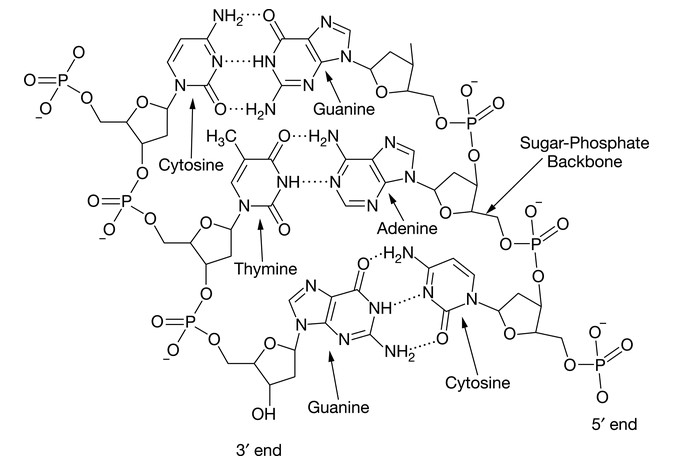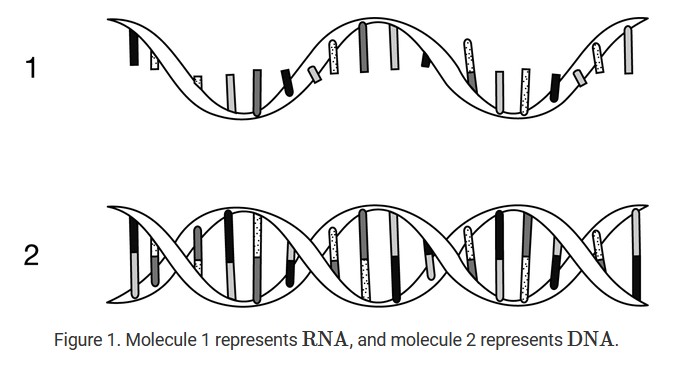Question

A student wants to modify model 1 so that it represents an RNA double helix instead of a DNA double helix. Of the following possible changes, which would be most effective in making model 1 look more like RNA than DNA?
A. Changing the sequence of the base pairs
B. Changing the deoxyriboses to riboses by adding −OH groups
C. Changing the shapes of the nitrogenous bases to match those shown in model 2
D. Changing the sugar-phosphate backbone to a ribbon, as shown in model 3
▶️Answer/Explanation
Ans: B
RNA contains ribose, whereas DNA contains deoxyribose. A ribose sugar has an −OH group linked to the 2′ carbon that a deoxyribose sugar does not have.
Question
Figure 1 shows a short segment of a double-stranded nucleic acid molecule.
Figure 1. A short segment of a double-stranded nucleic acid molecule
Which of the following statements is correct about the molecule shown in Figure 1 ?
A. It is RNA because of the relative direction of the two strands.
B. It is RNA because of the number of different nucleotides found in the molecule.
C. It is DNA because of the nature of the hydrogen bonds between guanine and cytosine.
D. It is DNA because of the nucleotides present.
▶️Answer/Explanation
Ans: D
The figure indicates that one of the nucleotides is thymine. Thymine is found in DNA and not in RNA.
Question

Which of the following best describes a structural similarity between the two molecules shown in Figure 1 that is relevant to their function?
A. Both molecules are composed of the same four nucleotides, which allows each molecule to be produced from the same pool of available nucleotides.
B. Both molecules are composed of the same type of five-carbon sugar, which allows each molecule to act as a building block for the production of polysaccharides.
C. Both molecules contain nucleotides that form base pairs with other nucleotides, which allows each molecule to act as a template in the synthesis of other nucleic acid molecules.
D. Both molecules contain nitrogenous bases and phosphate groups, which allows each molecule to be used as a monomer in the synthesis of proteins and lipids.
▶️Answer/Explanation
Ans: C
Nucleotides form base pairs with other nucleotides. The base pairing allows a strand of RNA or DNA to act as a template in the synthesis of other nucleic acid molecules. Examples include the cellular processes of DNA replication (DNA is used as a template to make DNA), transcription (DNA is used as a template to make RNA), and reverse transcription (RNA is used as a template to make DNA).
Question
COVID-19 is a single-stranded RNA virus. Which molecules would most likely be found in a single-stranded RNA virus, such as COVID-
19?
(A) adenine, cytosine, deoxyribose, guanine, thymine
(B) adenine, cytosine, deoxyribose, guanine, uracil
(C) adenine, cytosine, ribose, guanine, thymine
(D) adenine, cytosine, ribose, guanine, uracil
▶️Answer/Explanation
Ans:
(D) RNA contains ribose and uracil. Choice (A) is incorrect because
deoxyribose and thymine are found in DNA, not RNA. Deoxyribose is
found in DNA, not RNA, so choice (B) is incorrect. Choice (C) is
incorrect because thymine is not found in RNA; it is found in DNA.
Question
Which of the following is common to both DNA and RNA?
(A) the nitrogenous bases: adenine, cytosine, guanine, and thymine
(B) a double-stranded antiparallel helix
(C) a phosphate group attached to the 5′ carbon
(D) the five-carbon sugar ribose
▶️Answer/Explanation
Ans:
(C) Both DNA and RNA have a phosphate group attached to the 5′
carbon. Choice (A) is incorrect because RNA does not contain
thymine. A double-stranded antiparallel helix is only present in DNA,
not RNA, so choice (B) is incorrect. Choice (D) is incorrect because
ribose is present in RNA but not in DNA.
